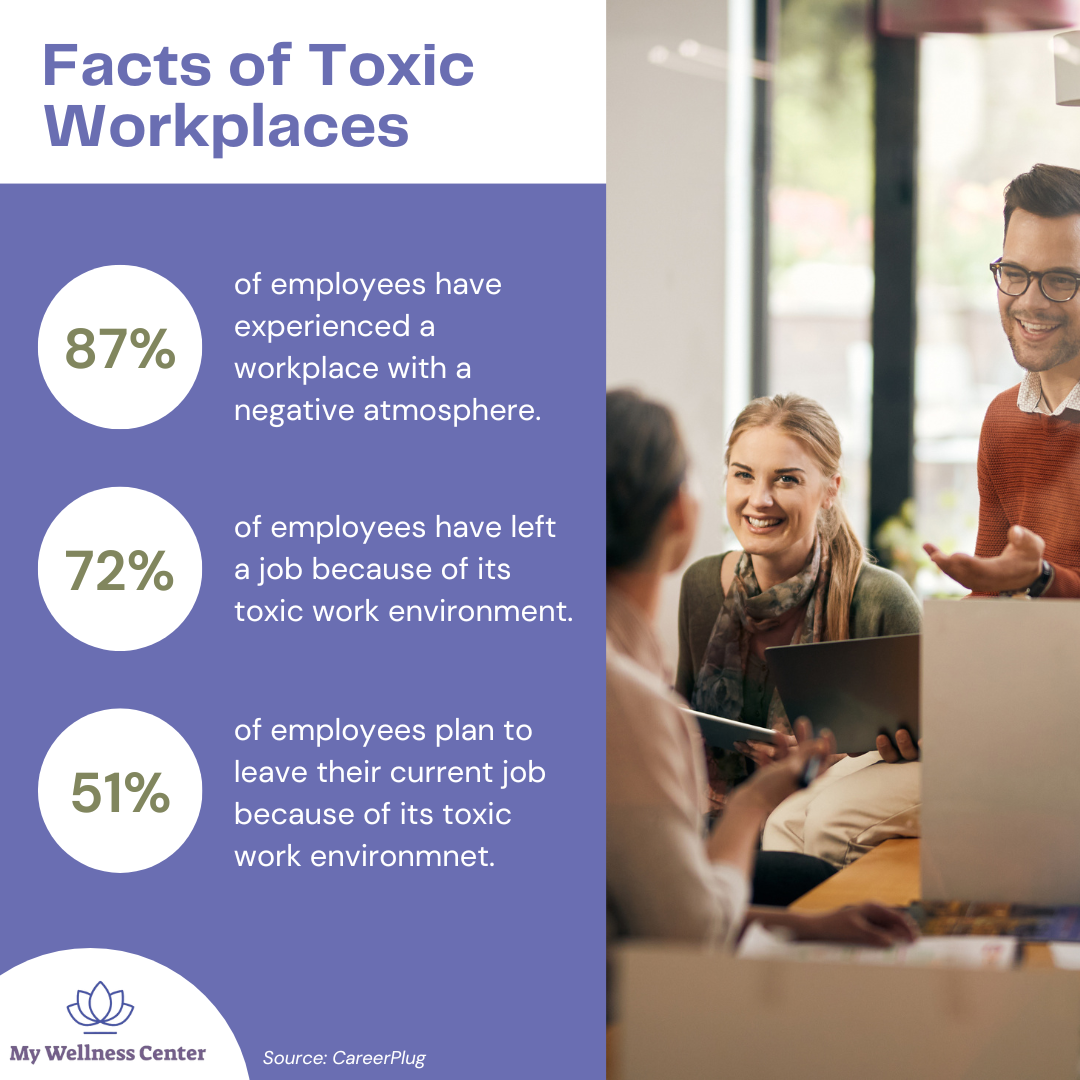Putting up with a toxic work environment is a little like holding onto a self-destructive relationship; you might not realize just how bad it is until you walk away from it.
Sadly, toxic workplaces are a common experience in the United States, with 87% of workers saying they’ve experienced a toxic workplace at some point in their work life.
And these environments can be deadly. A toxic workplace can destroy mental health, contribute to physical health issues, and can lead to problems in every other area of life.
Read our guide on how to survive a toxic workplace for additional resources.
Table of Contents
Which Industries Have the Most Toxic Workplaces?
Common Toxic Workplace Traits to Watch For
Physical And Emotional Impact of Toxic Workplaces
Therapy Treatment for Toxic Workplaces
Therapy for Toxic Workplaces

Which Industries Have the Most Toxic Workplaces?
A 2022 report from CareerPlug found the most toxic industries are:
- Fitness – 98% of employees have experienced a toxic work environment within the fitness industry
- Automotive – 94%
- Restaurant And Food Service – 91%
- Education and Childcare – 89%
- Insurance & Financial Service – 89%
- Personal Care – 89%
In western PA, however, our patients frequently complain about:
- Education – Teachers are frequently asked to do more with less, while facing pressures from students, parents, and administration. One of the biggest problems, though, is the difficulty in moving from one district to another. In many cases, the payscale at each district is different, and moving to another district may result in a serious pay cut, which leaves teachers feeling stuck.
- Tech – We frequently see employees in the tech industry complain about toxic work environments, especially in high-growth, uncertain sectors where companies hire at a quick pace and pay strong wages—only to eventually lay off huge portions of the team and put more work on the remaining team members.
- Healthcare – Healthcare professionals are regularly overworked, and workplace injuries are common among nurses and other medical staff who have direct physical contact with patients.
Common Toxic Workplace Traits to Watch For
If you want to survive a toxic workplace, learn the warning signs. Some of the most common traits of a toxic workplace include:
- Conflict Among Coworkers: Constant disagreements, gossip, and hostility among team members can create a stressful and unproductive environment. When interpersonal conflicts are not managed or resolved, it can lead to a pervasive sense of unease and distrust.
- Poor Work/Life Balance: A workplace that demands long hours with little regard for personal time can quickly lead to burnout. Employees in such environments often find themselves sacrificing family time, hobbies, and self-care just to keep up with work demands.
- Lack of Growth Opportunities: When a company does not provide clear paths for advancement or professional development, employees may feel stuck and undervalued. This stagnation can be demoralizing and lead to decreased motivation and engagement.
- Long Hours with No Breaks: Consistently working long hours without adequate breaks can take a toll on physical and mental health. It can lead to chronic fatigue, stress, and other health issues that affect overall well-being and productivity.
- Unfair Treatment by Managers: Favoritism, discrimination, and unfair disciplinary actions by managers can create a hostile and inequitable work environment. Employees who feel they are treated unfairly are likely to experience higher levels of stress and dissatisfaction.
- Control Issues: Micromanagement, excessive oversight, and lack of autonomy can stifle creativity and independence. Employees may feel powerless and suffocated, leading to frustration and resentment.
- Gaslighting: This manipulation tactic involves making someone doubt their own memory or perception. Phrases like “You must be imagining things” or “I never said that” are commonly used to undermine an employee’s confidence and sense of reality.
Physical and Emotional Impact of Toxic Workplaces
Physical Health Effects
A toxic workplace can have severe physical health consequences. Employees in such environments often face:
- Increased Risk of Heart Disease: Chronic stress and high-pressure situations can elevate blood pressure and increase the risk of heart attacks and other cardiovascular issues.
- Chronic Fatigue and Exhaustion: Long hours and inadequate rest can lead to persistent tiredness and reduced ability to perform daily tasks.
- Weakened Immune System: Continuous stress can weaken the immune system, making employees more susceptible to illnesses and infections.
- Musculoskeletal Problems: Poor ergonomics, coupled with high stress, can contribute to back pain, repetitive strain injuries, and other musculoskeletal issues.
- Sleep Disorders: Stress and anxiety from a toxic workplace can lead to sleep disturbances, including insomnia and restless sleep, which further exacerbates health problems.
Mental Health Effects
The mental health impacts of a toxic workplace can be just as damaging as the physical effects. These include:
- Anxiety and Depression: The constant stress and negativity can lead to severe anxiety and depression, affecting every aspect of an employee’s life. Learn more about our anxiety therapy services.
- Low Self-Esteem and Self-Worth: Being in an environment where one is consistently undervalued or criticized can erode self-confidence and self-worth.
- Burnout: Prolonged exposure to a high-stress work environment can lead to burnout, characterized by emotional exhaustion, cynicism, and reduced professional efficacy.
- PTSD-like Symptoms: In extreme cases, employees may experience symptoms similar to Post-Traumatic Stress Disorder, including flashbacks, severe anxiety, and avoidance behaviors related to work.
- Substance Abuse: Some individuals may turn to alcohol, drugs, or other unhealthy coping mechanisms to deal with the stress and pressure of a toxic workplace.
Addressing these issues often requires professional intervention, support systems, and sometimes a complete change of environment to facilitate recovery and well-being.
Therapy Treatment for Toxic Workplaces
Some of the most common treatment methods and services we use for toxic workplaces include:
1. Setting Up Support
In many of our therapy sessions related to toxic work environments, our team members assist patients in identifying long-term solutions that are already available to them.
Common outlets and pathways to a successful resolution:
- Union – If an individual is part of a union or has the ability to join a union, they may have more power and influence than they realize. A union exists to protect a worker and the worker’s rights, and the right therapist can help an individual identify the best solutions for moving forward.
- HR Department – A company’s human resource department should be equipped to manage interpersonal conflicts and conditions that result in toxic workplaces. In many cases, a trip to the HR department is often an individual’s first course of action in resolving a workplace dispute.
2. Psychoeducation
Educating an individual about common workplace issues and healthy responses to toxicity is another important step in therapy. For example, common discussion points include:
- What is gaslighting? Gaslighting—a manipulation tactic that involves getting someone to question their own sanity or memory—is a frequent complaint in toxic work environments. Workers may recall managers using phrases like Remember, you promised to do this! or I don’t remember promising that raise. You must have had that conversation with someone else.
- What is abuse of power? One of the most common experiences in a toxic work environment: An employee is being taken advantage of and pushed to do more than their position calls for. But reading through the job description and sticking to those requirements can help an employee prevent managers from pushing them to do more than required—or to pressure their workplace into offering a raise for the additional tasks.
- What is healthy boundary setting? Learning to set and enforce healthy boundaries is an important step in protecting oneself in the workplace. It’ll also teach you how to set expectations—both from what others can expect from you and what you can expect from others.
3. Other Therapy Techniques
Individuals are more likely to accept or enter a toxic workplace if they have a history of abusive relationships, childhood abuse, or other experiences where interpersonal toxicity was normalized instead of an exception.
By working through these traumatic experiences, we can help the individual recover and move beyond their past—and insist on stress-free workplaces that value them as individuals.
Therapy For Toxic Workplaces
To schedule therapy for your toxic workplace, contact us! Our compassionate therapists are trained to help you through your toughest challenges.

